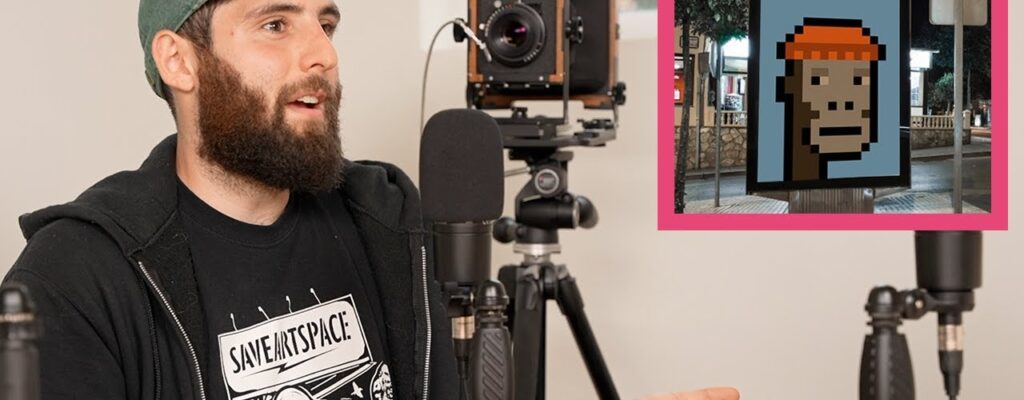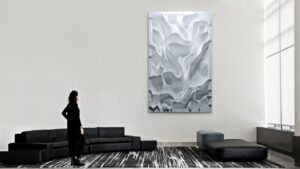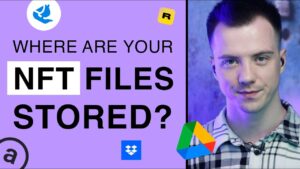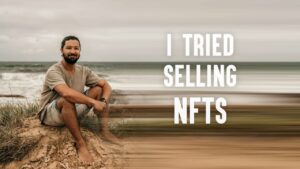Photographers have become popular as art collectors and are investing more money in their digital art. People have been paying astronomical amounts for their photographs. Especially if the image is iconic, people will pay a high price for it. XXXTentacion’s black and white photo by Aimos Vasquez is one of the most popular NFT projects and has the distinction of being the second most commented photo on the artist’s Instagram account.
In addition to democratizing the value of artwork, NFTs also serve as a way to sell the highest-quality photos. This would end the expensive commissions paid to galleries, ensuring that photographers earn a revenue. However, freelance photographer Faizal Westcott shares his experience with the NFT photography project. It cost $40 to upload one photo in Ethereum, a variable service fee within the Ethereum network. This was unacceptable, so he resorted to selling the image for a profit.
Carlos M. Almagro, a Tenerife-based photographer, combines hiking with night photography. The result is the NFT collection Under the Milky Way, which documents hidden landscapes and leans into niche genres. For the collection, he worked with partners Rarible and Pinhole. This collaboration has resulted in stunning images. The project is sure to be a hit with art lovers. There are many more such projects awaiting your discovery.
A new type of blockchain-based photography NFT project has emerged. The Phantasma and Ethereum blockchains are prime candidates for photography NFT projects. Both have been featured in a reddit blog exchange. They offer an alternative way to sell artwork, while simultaneously granting artists the opportunity to generate royalties. Unlike stock photography, the blockchain-based photography NFTs have no restriction on how they are sold. Therefore, it is a great way to sell artwork without any hassle.
Another project created by a photographer is called Into the Light Nature Photography Collective. The team is comprised of Mikko Lagerstedt and Enrico Fossati. The Genesis project was released in May. The NFTs are a great way to support a creative community that has made a significant impact on the art world. There are also several projects involving the art of other artists. You can find the latest and greatest photography NFTs at OpenSea.
Photography NFTs have become increasingly popular among art collectors. The art world is going through an unprecedented transformation, and NFTs are only set to continue to grow. The convergence of technological and cultural change is likely to continue to make this form of art an increasingly popular and valuable medium. In the meantime, photographers can continue to make money and expand their skills. They may find new appreciation for their digital art in the process. So, if you’re a photographer, now is the time to get involved.
Another interesting photography NFT project is the Six Street Under project. This project has a floor price of 2.25 ETH. Earlier this year, Whitehead put one of his photos on a low start auction for 0.40 ETH. The image ended up selling for 0.40 ETH and Jack Simpson won the auction. That’s an incredible return. These NFTs can sell for millions of dollars. There are also other projects in the works.
NFT photography marketplace
The NFT photography marketplace is an online platform that allows photographers to sell their digital artwork and earn money. It was launched in 2014, and the first NFT sold for millions of dollars. With their growing popularity, NFTs are here to stay. There are various NFT marketplaces out there, but the OpenSea is the largest and most popular. First, photographers must “mine” NFTs. Minting requires the use of cryptocurrency. Once you have your cryptocurrency, you can then sell your photographs to the public.
Rarible is an NFT marketplace for photography, and it accepts both Tezos and Flow. While the site is popular for 2D images and GIFs, it has been the scene of many successful artists. In addition to photography, some serious creators have made decent incomes with their photography NFTs. Some of these tokens have even reached $1,000. However, despite the large number of NFTs, you may find it difficult to reach a large audience with your work.
The growth of the NFT photography market is not only a result of the popularity of the NFTs, but also the high prices of digital art. The NFTs have also made digital art more accessible to buyers in other countries. While NFTs are a good solution for photographers who want to sell their work, some users are concerned that they will be ripped off by counterfeiters. However, if you have good quality NFT photography for sale, you can rest assured that you will have the best opportunity of making a profit from it.
Another NFT photography marketplace is OpenSea. While OpenSea is the best option for photographers looking for a platform where they can sell their work, Quantum Art also offers the largest portfolio of NFTs. OpenSea allows photographers to mint any volume of their images. With a variety of crypto currencies accepted, the NFT photography marketplace is sure to have something for everyone. Just remember to keep your wallet safe while you’re using it!
There are many other NFT photography marketplaces to choose from. The SuperRare NFT photography marketplace is governed by a network of curators and artists. NFT photography artists can submit their profile and have their work reviewed by a community. Once accepted, artists are paid a royalty of 10% from their sales and are charged a 15% seller fee. The NFT photography marketplace is a great opportunity for creative photographers to regain their place in the spotlight. Millions of talented photographers are confident in its potential, and pundits predict that NFT photography will explode by summer 2022.
The Foundation is another NFT photography marketplace. Artists who apply can sell their photography for NFT on the website. Artists receive a 10% royalty of their secondary sales, and the website also supports WalletConnect compatible wallets. Although the Foundation is an invitation-only NFT photography marketplace, it is home to some of the most beautiful and unique digital artworks available. Despite the platform’s high fees, it is an attractive choice for photographers interested in monetizing their NFTs.
Fine-art photography as NFT
Fine-art photography as NFT could revolutionize the way that digital art is sold. Fine Art photographers traditionally sold both physical and digital versions of their art. The latter is increasingly popular, but the market for these tangible versions has become oversaturated. Fortunately, the NFT marketplace is changing this dynamic. Here are four benefits of selling your fine-art photography as NFT:
The process of converting currency to NFT and paying GAS fees is complicated. It can be intimidating for photographers. However, the benefits are huge. Unlike traditional galleries, NFT-based galleries and other websites, photographers can sell their works online with little or no risk to their intellectual property. Those interested in selling their fine-art photography as NFT can join the Phantasma network, which associates works with NFTs. Other platforms are focused on digital drawing and smartphone applications, while Bitski supports the experience of Bryan Minear.
There are many photographers who have found success in the NFT space. Artists such as Justin Aversano have achieved incredible success with his Twin Flames collection. Likewise, Cath Simard is known for her ‘1-1’ landscape photography. Similarly, Isaac Wright, aka Driftershoots, has built an incredible movement in the NFT space. And the Where My Vans Go Collection is a perfect example of this movement.
By tokenizing photographs, collectors can enjoy exclusive ownership of them. Not only can other people look at the photos, but they can also take photos. The buyer of an NFT is also guaranteed ownership by the artist and has a certificate from him proving that they purchased it. This system also prevents counterfeits and theft of ownership. If done right, NFTs are a boon for artists. And if a photo is famous and collectible, it can have an even higher value than it would otherwise have.
While Mintable is not the only NFT marketplace, there are a lot of other places to sell your work. While it is free to join Mintable, the process of creating your first collection can be expensive. It is also crucial to note that the NFT marketplace is an invitation-only service. Moreover, you must be willing to pay a small service fee to the platform. It may be worth the small fee if you can make more money with your NFT.
The advantages of selling fine-art photography as NFTs include the opportunity to create a new market for art, as well as an easier way to make a living. It could also end the costly commissions that galleries pay for art. In fact, the cryptocurrency market is booming, and NFTs can help artists by offering a new revenue stream. In addition, the NFTs can help artists flex their digital art collections.
One of the biggest advantages of fine-art photography as NFT is the fact that it is easier to prove authenticity. Blockchain is already a proven way to authenticate digital works. Its ability to provide scarcity creates new monetization opportunities for artists. By creating a blockchain-based digital asset, NFTs can also be distributed to buyers worldwide. There are many benefits to selling fine-art photography as NFT, but it’s important to understand the ramifications before making the final decision.
NFT furniture
If you’re looking for unique pieces of digital collectible furniture, you’ve probably heard of NFT furniture. This is a growing collection of virtual furniture available in several different formats. And while the technology behind NFT furniture is still relatively new, the resulting pieces have many interesting uses. Not only can you create your own home decor, but you can also buy NFT-themed furniture. Read on to learn about these and other unique uses of NFT technology.
The designs of NFT furniture are based on a 13-second animation, which the designer freezes to create a real 3D-printed object. The NFT furniture collection includes chairs, tables, beds with mattress, storage pieces, bird baths, lighting, and more. Each piece in the collection is customizable and won by a single person or a group of people, and they can print each piece independently or through a studio. The furniture is conceptual and abstract, but it is also incredibly functional. Designer Jimmy Kahn aims to challenge the idea of furniture and create a new gesture for people to connect with.
As with any type of digital creation, there are risks and benefits to experimenting with NFTs. But, in the end, the potential for NFTs to transform the furniture industry is enormous. Andres Reisinger, for example, has sold virtual pieces of furniture that cannot exist in real life for $450,000! That’s quite an incredible feat for such a fanciful product. But the real thing is much more valuable.
The NFT furniture collection is a prime example of how blockchain can transform the luxury sector. Through the use of blockchain, it’s possible to create a certificate of uniqueness, which can add additional value to physical production. In this way, brands and designers can monetise their renderings and prototypes as NFTs. The resulting craze has generated a number of interesting applications for NFTs. The future of the luxury sector is just beginning.
NFT furniture isn’t just for luxury homes, but also for commercial use. There’s even a NFT-inspired biomorphic collection of furniture, designed by Misha Kahn for Christie’s. The exhibit is slated to run until 24 August 2021, marking Christie’s first ever sale of design NFTs. But even more interestingly, there’s a connection between NFT and cryptocurrency. While these two concepts might sound unrelated, they are actually connected and are very intriguing.
During my visit to 4SPACE last spring, I was intrigued by the idea of NFT furniture. It’s not only a new form of furniture, but also a way to bridge the gap between the virtual world and the real world. A Meta Chair Society chair comes with a virtual copy of a custom chair, which doubles as a digital invitation to exclusive design services. The launch week of the collection was a great success, with six chairs sold during launch week and trading for 2.9 Ethereum on OpenSea.
Reisinger has created five NFTs, each with a physical counterpart. These pieces include the Abba pink office chair and the Matsumoto plywood bench. Reisinger also recently launched three new NFT pieces for the first time through the gallery Nilufar. One piece, the Complicated Sofa, uses Mylar intestines to encourage the sitter to take up space, while another, the Bold chair, features a steel deck chair with a bubblegum-soft cushion.
NFT artist
If you’ve recently started a career in NFT art, the most important thing to remember is to enjoy the process. Every decision and piece of art you create will contribute to the story of your art career. It’s important to be patient and work consistently to achieve your goals. Eventually, you’ll become a successful NFT artist, but you’ll need time and consistency to get there. Luckily, there are a few tips to help you along the way.
To start, consider the benefits of becoming an NFT artist. Many artists have complained about the limited sales opportunities on Big Tech sites. While they may generate visits and engagement, these sites often yield minimal revenue. By contrast, NFTs allow artists to create and sell their digital art while building a community and career. NFT artists, as opposed to traditional gallery owners, earn more money by selling their work online, making NFT art an ideal option for both established and new artists.
Next, consider using social media to promote your art. Social media can help supplement your website traffic, and you should join all the popular social media platforms, including Instagram and Facebook. A website can showcase your NFT art collection, provide links to a marketplace, and even have a blog that draws traffic organically. This can help you gain a following and make your work more visible to potential buyers. However, do not forget to include your bio, as it can help you gain credibility.
Another example of a popular NFT artist is Micah Johnson. This Seattle-based artist was born Victor Langlois and began selling paintings at a young age. His digital NFT art reflects his heart. He earns more than $17 million a year from his work. It’s no wonder he’s one of the top NFT artists. However, there are many others who deserve to be on this list. The list isn’t complete without these artists.
The first step in establishing a successful NFT art career is choosing a niche. There are plenty of art NFT niches to choose from, including photography, painting, doodles, and music. The goal is to find a topic that you’re passionate about, so that you can create a unique and memorable art product. If you’re unsure, start with something simple and niche-specific. Don’t worry about getting bored with the same old things; you can always change the subject or style.
Another promising NFT artist is Fvckrender. The Scottish artist has sold more than 6,700 NFTs and has more than half a million followers on social media. He’s worked with major artists such as Gunky’s Uprising and collaborated with 3LAU. His Merge collection has become one of the best-selling digital art NFTs. He’s currently working on a much larger project. A new NFT art gallery will open soon.
Before you begin selling NFT art, you should determine how much you’re willing to charge for your work. Research similar artists and how much they’re charging for similar works. Remember that if you’re a new artist, it may be difficult to command high fees. So, it’s crucial to learn as much as you can about the market and your competition. You also need to market your art to your target audience. You’ll need to develop a social media presence to promote your work.





